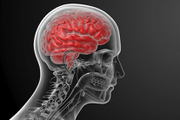The Role Of Helmets In Protecting The Brain

During our last blog post, we learned the changes that occur within the brain on a cellular level following a concussion and how this affects healing. Today we’ll be discussing the different kinds of helmets available and how they work to help protect the brain during a collision.
First, we need to know on a broad scale what happens to the brain during a collision. The brain is a free floating structure within the skull suspended within fluid called cerebrospinal fluid. As a result, the brain will move at a different rate within the skull in response to a collision. The high speed deceleration of the skull causes the brain to collide within the skull on impact, which is called a coup injury (pronounced "coo"). Following the initial impact of the brain on the skull, the brain will then reverberate off of the side of initial impact into the opposite side of the skull, causing a contrecoup injury. This will result in an injury to two sides of the brain relative to the direction of the impact.

So how do helmets work?
One common misconception with respect to wearing a helmet is the idea that a helmet will prevent an individual from having a concussion during a high impact collision. Depending on the severity of impact, even with a helmet on, an individual can receive a traumatic brain injury. Now, the role of a helmet is to reduce the acceleration of the skull during a collision, absorbing some of the forces being transferred to the brain on impact. Thus decreasing the severity of damage to the brain on high impact collisions and helping to prevent concussions on lower impact collisions.
Are Rotational Dampening Systems such as MIPS and SPIN technology effective?
More traditional helmets were designed to help reduce the acceleration of the skull upon linear impact, meaning the impact is coming from one direction. However, what happens if you fall and hit your head at an oblique angle? Rotational forces transferred to the brain upon impact can cause significant injuries for which a standard helmet does not accommodate. Helmets with MIPS (Multi-directional Impact Protection System) and SPIN (Shearing Pad Inside) technology have a separate shell on the inside of the helmet that allows the outer shell to rotate upon an oblique impact. A study comparing the effectiveness of standard helmets vs. rotational dampening systems at reducing the rotational force transferred to the head found that the rotational dampening systems were more effective by 42% for MIPS and 54% for SPIN technologies at reducing the likelihood of sustaining a mild-moderate concussion based upon their Brain Injury Criterion. These results indicate that the rotational dampening systems are effective in reducing the likelihood of sustaining a brain injury following impact. These systems are available in bike helmets and ski/snowboarding helmets for the time being, but may be an area of investigation for future implementation into helmets for other sports as well.

References
Bottlang, Michael, et al. "Impact performance comparison of advanced bicycle helmets with dedicated rotation-damping systems." Annals of Biomedical Engineering 48.1 (2020): 68-78.
Daneshvar, Daniel H., et al. "Helmets and mouth guards: the role of personal equipment in preventing sport-related concussions." Clinics in Sports Medicine 30.1 (2011): 145-163.


